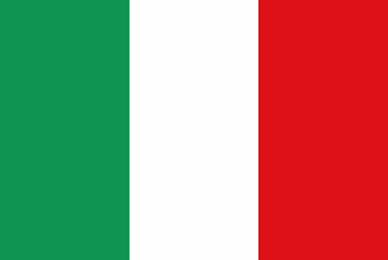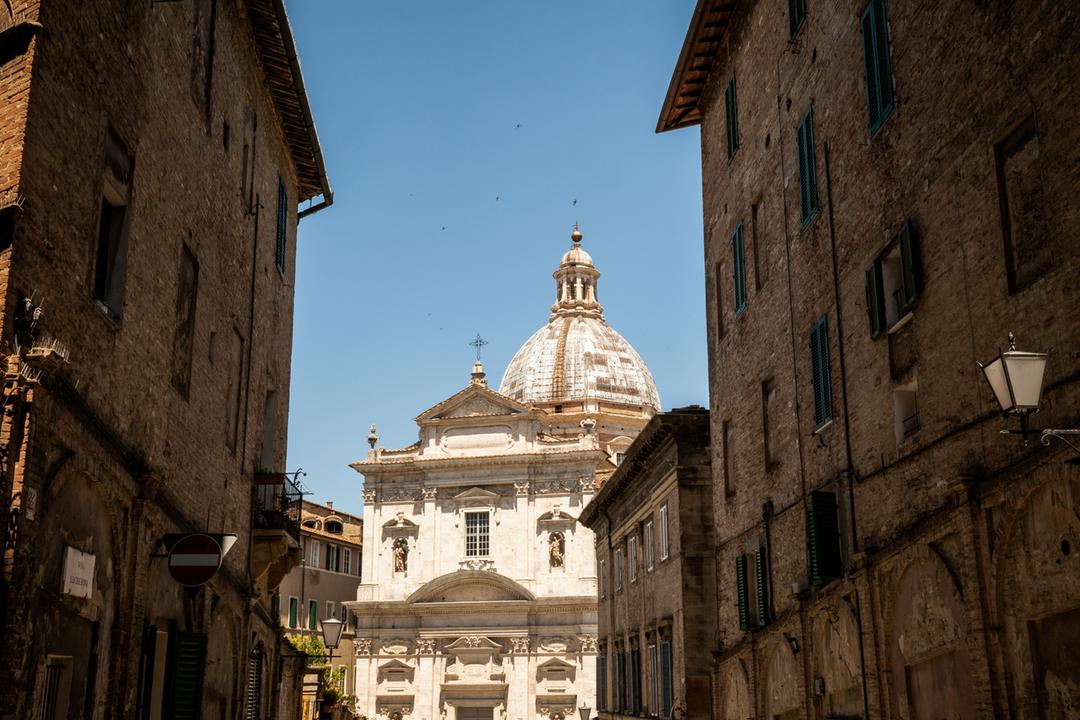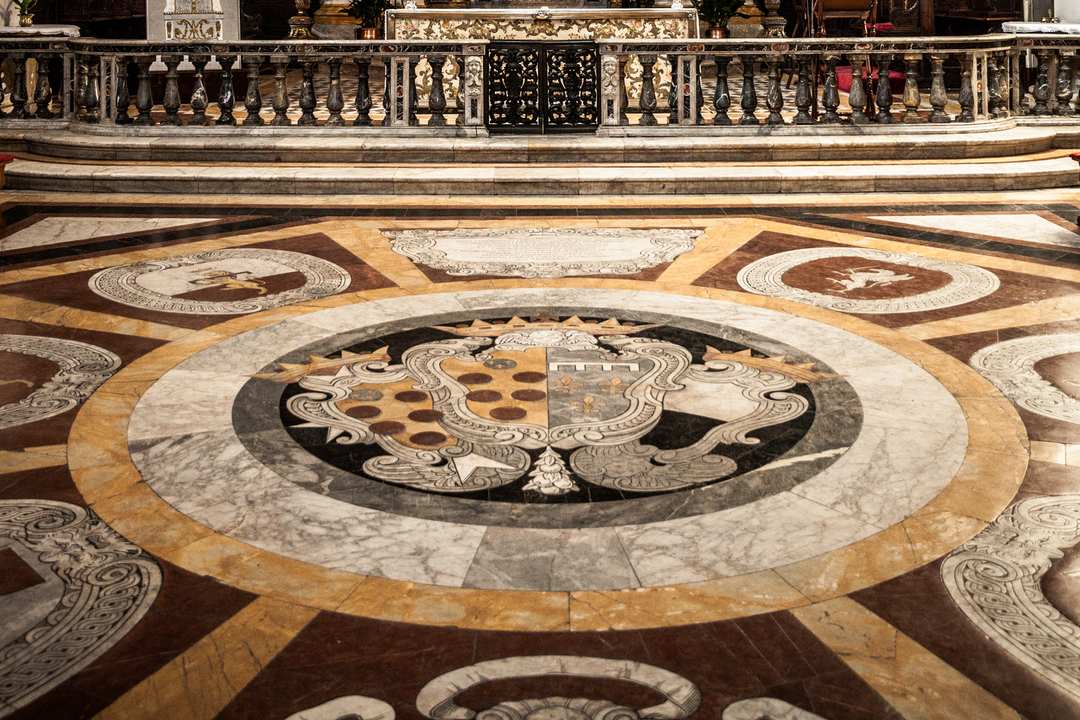





L'Insigne Collegiata di Santa Maria in Provenzano conserva sull'altare maggiore un busto in terracotta della Madonna venerata per un lungo elenco di miracoli realizzati nella seconda metà del Cinquecento. Il primo fu quello relativo all'episodio di un soldato spagnolo che, con gesto blasfemo, sparò con il suo archibugio contro l'immagine sacra, mandando in frantumi la parte bassa del busto e risparmiandole solo il volto e le spalle; partito il colpo, però, l'arma implose e uccise il soldato. Alla Madonna di Provenzano è dedicato il Palio del 2 luglio: subito dopo la vittoria, i contradaioli si recano in questa chiesa con il drappellone avuto in premio per cantare il tradizionale ringraziamento alla Vergine. La costruzione della chiesa ebbe inizio nel 1595 su modello del monaco certosino Damiano Schifardini, e fu diretta da Flaminio del Turco. L’aspetto architettonico si rifà al prototipo della chiesa del Gesù a Roma progettata dal Vignola e che meglio corrisponde ai criteri della Controriforma. La chiesa fu consacrata nel 1611.
The famous Collegiata di Santa Maria in Provenzano (this is the complete name) has on the main altar a terracotta bust of the Virgin venerated for a long list of miracles that happened in the second half of the sixteenth century. The first one was about a Spanish soldier who, for a blasphemous joke, pointed his harquebus against the sacred image, shattering the low part of the bust and sparing only the face and the shoulders. But the weapon, instead of shooting imploded and killed the soldier. The Palio of the 2nd of July is dedicated to the Virgin of Provenzano: immediately after the victory, the Contrada members go to this Church with the drappellone (the big drape, which is the Palio itself) received as a prize for singing the traditional Te Deum of thanksgiving to the Virgin. The construction of the church began in 1595 on the project of the Certosino monk Damiano Schifardini, and was directed by Flaminio del Turco. The architectural aspect refers to the prototype of the church of 'Il Gesù' in Rome designed by Vignola and better corresponds to the criteria of the Counter-Reformation.The church was consecrated in 1611.
Die Collegiata di Santa Maria in Provenzano (das ist eine Kollegiatkirche) bewahrt über dem Hochaltar eine Büste der Madonna di Provenzano aus Terrakotta auf, die verehrt wird, da man ihr eine Reihe von Wundern in der zweiten Hälfte des XVI Jahrhunderts zugeschrieben hat. Das erste Wunder bezieht sich auf eine Episode, bei der ein spanischer Soldaten mit einer blasphemischen Geste auf die Büste der Madonna schoss; die Pistole implodierte jedoch, und der Soldat starb, während nur der untere Teil der Büste zerstört wurde und das Gesicht und Schultern unversehrt blieben. Der Palio am 2. Juli findet zu Ehren der Madonna di Provenzano statt. Nach dem Sieg erhält die Sieger-Contrade den Palio (die jährlich neu gestaltete farbige Standarte), und die siegreichen "Contradaioli" (die Bürger der Contrade) begeben sich sofort mit dieser Standarte in die Kirche Santa Maria di Provenzano, um der Madonna mit dem traditionellen Gesang Dank zu erweisen. Der Bau der Kirche begann 1595 nach dem Entwurf des Kartäuser Mönchs Damiano Schifardini und die Bauleitung übernahm Flaminio del Turco. Der Stil der im Jahre 1611 geweihten Kirche entspricht dem Stil der Jesuskirche in Rom, die von Vignola entworfen wurde, und besser die Regeln der Gegenreformation aufgenommen hat.
La Collégiale Santa Maria in Provenzano conserve sur l'autel majeur un buste en terre cuite de la Vierge vénérée pour une longue liste de miracles réalisés durant la seconde moitié du XVIe siècle. Le premier fut celui relatif à l’épisode d’un soldat espagnol qui, avec un geste blasphème, tira avec son arquebuse contre l’image sacrée de la vierge, en détruisant la partie inférieure du buste; seulement le visage et les épaules furent épargnés; une fois le coup parti, l'arme explosa et tua le soldat espagnol. Le Palio du 2 juillet est dédié à la Vierge de Provenzano: après la victoire, les membres des quartiers se rendent dans cette église avec le Palio gagné pour chanter le traditionnel remerciement à la vierge. La construction de l’église commença en 1595 sur le modèle du moine Damiano Schifardini et sous la direction de Flaminio del Turco. L’aspect architectural ressemble à l’église du Gesù à Rome sur projet de Vignola qui correspond à la Contreréforme. L’église fut consacrée en 1611.
La distinguida Colegiata de Santa María en Provenzano conserva en el altar mayor un busto en terracota de la Virgen venerada por una serie de milagros realizados en la segunda mitad del siglo XVI. El primero estaba relacionado con el episodio de un soldado español, que con un gesto blasfemo, disparó con su arcabuz contra la imagen sagrada, destrozando la parte inferior del busto y salvando solo su rostro y hombros; después del golpe, sin embargo, hubo una implosión en el arma y mató al soldado. A la virgen de Provenzano fue dedicado el Palio del 2 de julio: enseguida después de la victoria, los contradaioli (miembros de la contrada) se dirigen hacia esta iglesia con el drappellone (trapo) recibido como premio para cantar el tradicional agradecimiento a la Virgen. La construcción de la iglesia comenzó a principios del 1595 siguiendo el modelo del monje de Certosino Damiano Schifardini, y fue dirigida por Flaminio del Turco. El aspecto arquitectónico se refiere al prototipo de la Iglesia del Jesús en Roma, diseñado por el Vignola y que corresponde mejor a los criterios de la Contrarreforma. La iglesia fue consagrada en el 1611.

Luoghi
A few hours or even just one day is definitely not enough to discover Siena and experience it in all its aspects.
Thanks to a priceless historical and artistic heritage and to a rich net of commercial activities, Siena offers many cultural, entertainment and travel opportunities. Breathtaking views and hidden corners, confirmations and surprises await you behind every alley and in every square with unusual perspectives to be discovered also through the itineraries that we show you in this page.
The routes that vary according to the number of days, to your passions, to the season and to the will to either walk or rather relax in the city's green spaces. Many different ways to achieve a single objective: making your travel experience in our city unforgettable.
So, enjoy Siena! And thank you for spending your free time in our city.
We’ll always remain here, waiting for your next visit.



